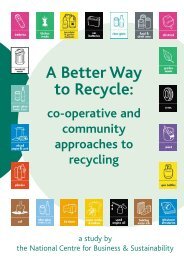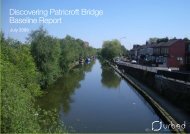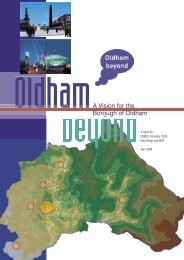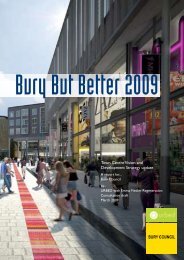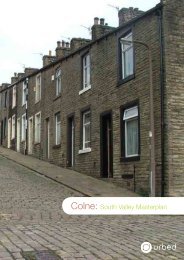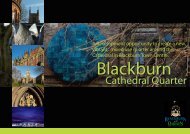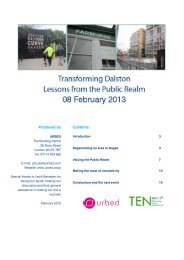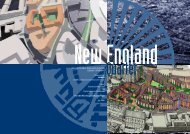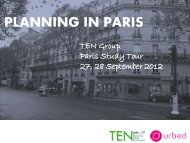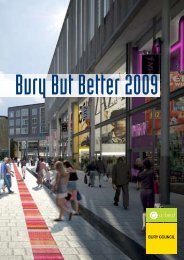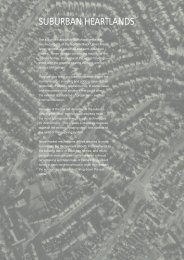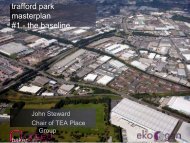Beyond Eco-towns Applying the Lessons from Europe - Urbed
Beyond Eco-towns Applying the Lessons from Europe - Urbed
Beyond Eco-towns Applying the Lessons from Europe - Urbed
You also want an ePaper? Increase the reach of your titles
YUMPU automatically turns print PDFs into web optimized ePapers that Google loves.
1 2<br />
In Hammarby, <strong>the</strong> so called ‘Hammarby Model’ had been developed through collaboration between <strong>the</strong><br />
local authority cleansing department, water company and energy company, <strong>the</strong>reby creating a virtuous<br />
circle of turning waste products into energy or returning <strong>the</strong>m to <strong>the</strong> environment in a useful and harmless<br />
form. The Water Cycle shows how to turn a problem into an opportunity.<br />
6.4 Character<br />
<strong>Eco</strong>-<strong>towns</strong> should have a strong identity, and offer a choice of attractive places to live<br />
in a green and pleasant setting, which helps <strong>the</strong>m to grow relatively fast.<br />
In every case, our examples passed <strong>the</strong> ‘would I really like to live here’ test. They felt pleasant, safe and<br />
comfortable places to walk around, with high quality streets and open spaces. Cafés and small shops<br />
enlivened <strong>the</strong> street scene and encouraged social interaction.<br />
Most of <strong>the</strong> examples were at low to medium density (30-50/ha net) which enabled family housing to be<br />
provided, ei<strong>the</strong>r as terraced houses or small walk up blocks of flats or maisonettes. Even at Hammarby,<br />
where all <strong>the</strong> accommodation is in apartment form, <strong>the</strong>re are a high proportion of families with young<br />
children. This was partly because of <strong>the</strong> large size of <strong>the</strong> individual homes but also because of <strong>the</strong> child<br />
friendly nature of <strong>the</strong> layout and <strong>the</strong> provision of schools and nurseries <strong>from</strong> day one.<br />
In most cases, <strong>the</strong> architectural treatment was relatively simple and restrained, often enlivened with<br />
colour and with planting draping over balconies. Where eco-technology was being used, it did not unduly<br />
impinge on <strong>the</strong> architecture (though <strong>the</strong> incorporation of solar panels into <strong>the</strong> roofs of blocks of housing,<br />
as in part of Vauban and Rieselfeld in Freiburg creates places that look distinctive).<br />
It was noticeable that in many cases <strong>the</strong> designers had set out to create a very distinctive and specific<br />
identity. In Hammarby, this related very directly to <strong>the</strong> scale and grain of <strong>the</strong> city centre of Stockholm,<br />
re-interpreted in a modern idiom. In Amersfoort, <strong>the</strong> three separate developments chose to ‘brand’<br />
<strong>the</strong>mselves in different ways based on <strong>the</strong>mes such as water or woodland. In Vathorst <strong>the</strong> marketing<br />
tag is ‘A world of difference’ reflecting <strong>the</strong> very varied architecture of <strong>the</strong> development.<br />
In all cases <strong>the</strong> spaces between <strong>the</strong> buildings were as important as <strong>the</strong> buildings <strong>the</strong>mselves and<br />
had been designed with great care and attention to detail. Natural landscape features had often been<br />
retained, for instance a mature oak woodland in Hammarby or old farm buildings and cart tracks in<br />
Vathorst. In many cases water had been used as a focus, whe<strong>the</strong>r it is an existing water body, newly<br />
created one or using sustainable urban drainage (SUDS) as landscape features.<br />
20



